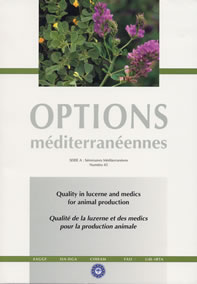| Article précédent | p. 19-23 | Article suivant |
From description to explanation of variations in alfalfa digestibility
Feeding value of alfalfa shows variations due to the genotype and to the environment. A part of the genetic variation is not explained by morphological or phenological differences, and could be related to intrinsic traits of the plants. A detailed description of dry matter and fibre degradation in the rumen of fistulated cows showed variations in both extent and rate of degradation. Preliminary data on the histological bases of variations in stem digestibility are presented. Some histological traits evolved along the stem, and others varied with the genotype. Molecular mapping is under study, with the objective of identifying markers associated to this group of growth and digestibility traits. With this approach, the relationship between these components should be better understood, and molecular markers could be tool kits for alfalfa breeders. The autotetraploidy of this species complicates the approach, but alfalfa takes benefits from the basic studies made on the legume model species, M. truncatula.
- [ Afficher ]
- [ Télécharger ]
- [ Exporter la citation ]
Vous pouvez télécharger la citation au format :
- [ Imprimer ]
-
Mots-clés
DEGRADATION, EXPERIMENTATION IN SACCO, MEDICAGO SATIVA, PAROI CELLULAIRECiter cet article
Julier B., Guines F., Ecalle C., Huyghe C. From description to explanation of variations in alfalfa digestibility. In : Delgado I. (ed.), Lloveras J. (ed.). Quality in lucerne and medics for animal production . Zaragoza : CIHEAM, 2001. p. 19-23. (Options Méditerranéennes : Série A. Séminaires Méditerranéens; n. 45). 14. Réunion Eucarpia du Groupe Medicago spp., 2001/09/12-15, Zaragoza and Lleida (Spain). http://om.ciheam.org/om/pdf/a45/01600049.pdf



